Glue has a long history, from its first uses as a bonding material to the multiple applications we now associate with adhesives. It has been used in many processes you probably haven’t even thought of. Where did glue begin, and how has it been used and developed to become the bonding material we use today?
A very early history
The first use of glue was probably the resin of the birch tree around 200,000 years ago. This unadulterated substance was a basic adhesive that had become further developed over 7,000 years ago when it was heated to create a birch polymer; this would have involved a great deal of precision and demonstrates that curing was taking place early in its history.
Animal glues
Animal by-products were being used in the production of glue 5,000 years ago, notably in Egypt. Animal hides, hooves and their connective tissues were boiled to create a glue that was used in furniture making and papyrus reinforcement. Evidence has been found of glue being used in the tombs of mummies. Tutankhamun’s tomb contained evidence of glue usage.
Gluing an empire
The Romans and Greeks made excellent use of adhesives, as we can see today in the extensive examples of original mosaics, floor and wall tiles that have been uncovered. They used adhesives in building construction as well, widening the remit of adhesives. The use of glue fell along with the empire, and it wasn’t until the early modern world that it was used again.
Glue extended beyond Rome and Greece, and examples were found in the Far East in China as well as in Africa and North and South America.
Modern glues
Advances in science and increased transport links led to the re-emergence of glue. While animal glues were still being used, other substances were employed to make sealants – such as lime, ash and sand – along with egg-based glues and tar-based glues used in boat building extensively. It would be a while before rubber and synthetic glues were manufactured industrially, like the metal bonding adhesive products found at.
The industrial revolution from mid-1800s saw the development of adhesives move away from animal-based options towards synthetic ones with the creation of superglues. This brought a massive increase in potential applications spanning many industries including building, automotive and aerospace.





